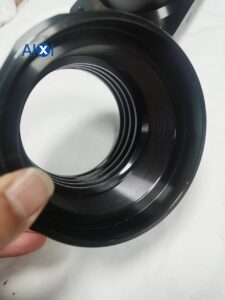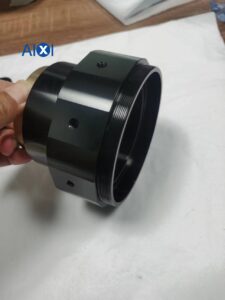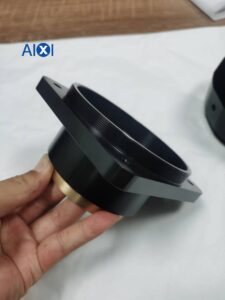Aluminum is a popular material, and manufacturers prefer it due to its lightweight. However, it has some drawbacks, like limited rust protection and durability. So, it undergoes an anodizing process so that manufacturers get the desired rust protection. This raises the question of whether anodized aluminum is better than regular aluminum.
You might argue that aluminum makes aluminum oxide natural. Right? However, this natural oxide layer is not very robust and breaks down. As a result, rust starts to deteriorate the product. That’s where the anodized aluminum comes in handy. So, why do manufacturers not use this anodized aluminum in all their products? You’ll get an answer in this article.
What is Anodized Aluminum?
Aluminum undergoes an anodizing process, which is called anodized aluminum. It has a thick and strong oxide layer due to the anodization process. This additional oxide layer is more robust and thicker than the natural aluminum’s oxide layer. As a result, aluminum becomes more durable and safer against rust.
I’ve already written a complete article on aluminum anodizing. This process adds a layer as a result of the electrochemical process. Regular aluminum doesn’t have this additional layer. The method uses an acid solution. Then electricity is passed through this solution. The aluminum is dipped in this solution to get an oxide layer.
This additional oxide layer protects the aluminum from rusting. Moreover, it also increases the overall look of aluminum. You can add different dyes to the acid solution. As a result, the aluminum gets a different color depending on the dye you add. It all makes aluminum more attractive and suitable for decorative purposes.


Aluminum vs Anodized Aluminum: Which is Better?
I consider anodized aluminum a superior option to a normal one. It offers better rust protection and durability. Moreover, an additional oxide layer gives aluminum a matte, glossy look. As a result, it becomes more aesthetically pleasing and ideal for decoration products.
Even if anodized aluminum is exposed to harsh conditions, its oxide layer will remain safe. Moreover, this aluminum has a solid oxide layer, so scratches won’t affect its quality. But this is one side of the picture: this aluminum type also has drawbacks.
The anodizing process is expensive and requires a handsome budget. On the other hand, regular aluminum is a relatively cheaper material. If you want to keep product prices low, I prefer regular aluminum. However, if quality is your concern, you should only use anodized aluminum.
In the section below, I will discuss other reasons that make anodized aluminum a superior option.
1- Anodized Aluminum Is Stronger
Anodized aluminum is more complex and more resistant to corrosion than pure aluminum. The process of anodizing is performed to increase the thickness of the natural oxide layer. It also increases its strength in cold weather conditions. Unlike steel, anodized aluminum does not flake or peel. This makes it the ideal material for outdoor furniture, boat parts, and other applications.
2- Anodized Aluminum is More Corrosion-resistant
Anodized aluminum is more corrosion-resistant due to the strong oxide layer. However, you might argue that regular aluminum comes with a natural oxide layer. Unfortunately, it is not very strong and effective and can only provide small protection against rust. If such aluminum remains in harsh conditions, moisture will cause this layer to break.
Rust will deteriorate the quality of such material. However, anodized aluminum has a thicker oxide layer, which is hard to break. This aluminum performs well even if used in the harshest conditions. Manufacturers generally use anodized aluminum to make many marine products. Such items are exposed to salty water and still don’t rust easily.
3- Anodized Aluminum Is Non-Reactive
The surface of anodized aluminum is non-reactive, making it very safe to use in the kitchen. While aluminum is inexpensive, it has many drawbacks and can react with certain foods.
It can cause discoloration in food when it comes into contact with acidic or hot foods. Therefore, it is necessary to choose non-reactive aluminum cookware. The surface of a pot or pan is usually made of anodized aluminum.
4- Aesthetics and Looks
Anodized aluminum consists of an additional thicker oxide layer. It has a more matte, glossy look, which enhances its appearance. Moreover, manufacturers also add different colors or dyes during the anodizing process. Those dyes give different shades and look aluminum. Even without dyes, anodized aluminum looks matte and glossy. From a distance, it attracts anyone who sees it. So, it is ideal for making decorative products. Typical aluminum doesn’t have such a visually appealing appearance.
5- Scratch Resistance & Reliability
As I said, anodized aluminum has a very thick artificial oxide layer. Due to this additional thickness, the aluminum surface remains safe from scratches. It won’t be wrong to say that anodized aluminum is scratch-proof. On the flip side, typical aluminum has a weak oxide layer, so the chances of scratches are higher. As anodized aluminum doesn’t rust, it gets scratched, proving more reliable and durable.
Frequently Asked Questions
Is anodized aluminum safer than aluminum?
Yes, anodized aluminum is non-reactive. So, using it in cookware is always safe as this aluminum doesn’t leach into the food. You won’t get any issues while eating food cooked in cookware made of anodized aluminum. Cookwares made with typical aluminum can leach some aluminum into food.
How long does anodized aluminum last?
Anodized aluminum can easily last for 15 to 25 years. If you take care of this material, it can stay in good shape for 35 years.
Is anodized aluminum good for health as compared to regular aluminum?
Yes, anodized aluminum is a safe material for health. It is non-toxic, so it is used to make cookware. Food cooked in those cookware is always secure, as the aluminum does not leach into the food.
Conclusion
There are two main drawbacks of anodized aluminum: its higher price and limited repairability. Someone with a tight budget should avoid using this material. It will make your product very expensive and less profitable. Moreover, if the anodized layer is damaged, you can never repair it.
However, this additional layer is generally robust and doesn’t break. Do you want to know my verdict? I still consider anodized aluminum a suitable option for most of the cases. Its higher prices offer excellent perks. You get better corrosion resistance, scratch resistance, and an aesthetically pleasing look. It will surely improve the quality of your product.

 Deutsch
Deutsch Français
Français 日本語
日本語 Español
Español
